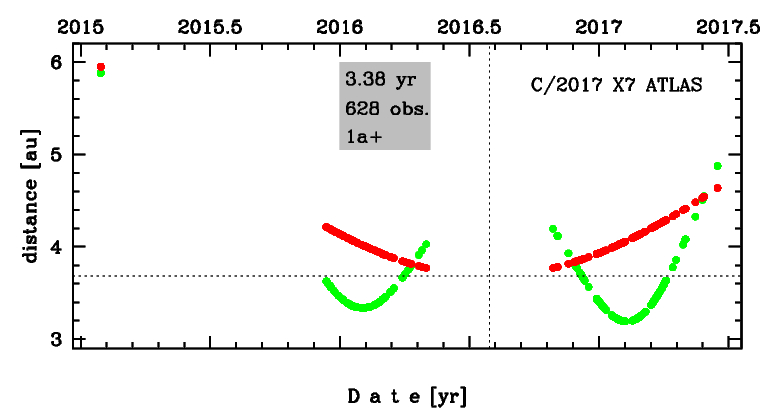C/2015 X7 ATLAS
more info
Comet C/2015 X7 was discovered on 12 December 2015 by Asteroid Terrestrial-impact Last Alert System (ATLAS) Team, that is about 7.5 months before its perihelion passage. Some prediscovery images of this comet were found: taken on 28 January 2015 by Pan-STARRS 1, Haleakala. This comet was observed until 16 June 2017.
Comet had its closest approach to the Earth on 8 February 2017 (5.909 au); about 6 months after its perihelion passage.
Solutions given here are based on data spanning over 2.38 yr in a range of heliocentric distances: 5.95 au – 3.685 au (perihelion) – 4.64 au.
This Oort spike comet suffers small planetary perturbations during its passage through the planetary system that lead to a more tight future orbit with a semimajor axis of about 5,000 au (see future barycentric orbits).
Comet had its closest approach to the Earth on 8 February 2017 (5.909 au); about 6 months after its perihelion passage.
Solutions given here are based on data spanning over 2.38 yr in a range of heliocentric distances: 5.95 au – 3.685 au (perihelion) – 4.64 au.
This Oort spike comet suffers small planetary perturbations during its passage through the planetary system that lead to a more tight future orbit with a semimajor axis of about 5,000 au (see future barycentric orbits).
| solution description | ||
|---|---|---|
| number of observations | 628 | |
| data interval | 2015 01 28 – 2017 06 16 | |
| data type | perihelion within the observation arc (FULL) | |
| data arc selection | entire data set (STD) | |
| range of heliocentric distances | 5.95 au – 3.69 au (perihelion) – 4.64 au | |
| detectability of NG effects in the comet's motion | comet with determinable NG~orbit | |
| type of model of motion | GR - gravitational orbit | |
| data weighting | YES | |
| number of residuals | 1239 | |
| RMS [arcseconds] | 0.44 | |
| orbit quality class | 1a+ | |
| orbital elements (heliocentric ecliptic J2000) | ||
|---|---|---|
| Epoch | 2016 07 31 | |
| perihelion date | 2016 07 30.23332213 | ± 0.00033015 |
| perihelion distance [au] | 3.68453191 | ± 0.00000120 |
| eccentricity | 1.00175589 | ± 0.00000278 |
| argument of perihelion [°] | 348.485633 | ± 0.000051 |
| ascending node [°] | 139.883839 | ± 0.000006 |
| inclination [°] | 57.580939 | ± 0.000007 |
| reciprocal semi-major axis [10-6 au-1] | -476.56 | ± 0.75 |
